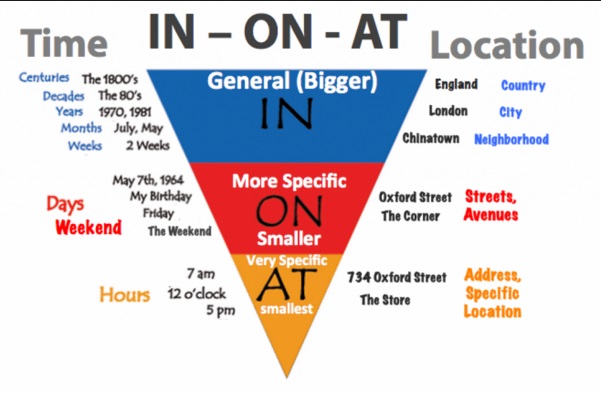“Prepositions of Place and Time “
* Introduction
The following information and rules will help you use prepositions of place and time correctly.
Prepositions of Place (Location/Destination)

1. Use “on” with lines and surfaces.
Vancouver is on the west coast of Canada. line
Put the vase on the table. surface
They were sitting on the grass. surface
2. Use “in” with areas that have boundaries and enclosed places.
I was born in England, but I grew up in Canada. areas that have boundaries
We had a picnic in the park last Saturday. enclosed place
I think I left my keys in the bedroom. enclosed place
3. Use “arrive” + “at” with activities, buildings and general locations.
Everyone arrived at the picnic at the same time. activity
The tour group will arrive at the Empire State Building at three o’clock. building
The bus arrived at the station earlier than we expected. location
4. Use “arrive” + “in” with countries, states and cities.
Which month did you arrive in Victoria?
5. Prepositions are not used with the following locations or destinations:
overseas, inside, here, home, upstairs, downtown, abroad, outside, there, where, downstairs
6. Some other prepositions of location are: next to, beside, between, in front of, under.
On my desk, the telephone is next to the lamp.
The computer monitor is beside the lamp.
The speaker is between the telephone and the monitor.
The keyboard is in front of the monitor.
The computer is under the desk.
7. Use “to”, “into”, and “onto” to show movement.
When our car broke down, we walked to the nearest gas station.
The delivery people carried the new couch into the living room.
The man slipped, and fell onto the couch.
Note: The opposite of “to” is “from” / the opposite of “into” is “out of” / the opposite of “onto” is “off”.
8. Some other prepositions which show movement are: through, across, up, down, along, past
The train went through a tunnel.
When the forest fire started, the deer swam across the river to safety.
We walked up/down/along the street until we found a restaurant.
The parade went past city hall and ended at the new arena.
Prepositions of Time
1. Use “at” for specific times.
The movie starts at 7:00.
2. Use “in” with months, seasons, and years.
We got married in December.
Most people prefer to get married in the spring or summer, but we chose to get married in the winter.
Note: We say “in the morning”, “in the afternoon”, and “in the evening”, but we say “at night” and “by day”.
3. Use “on” for days and dates.
I had to work late on Wednesday, so I missed the bus. day
Diane’s friends held a party for her on her birthday. date
4. Use “since” to say when an activity began, and “for” to say how long it has been going on.
He has been president of the company since 2003.
We have been waiting for twenty minutes.
I have lived here for two years.
Note: The present perfect is often used with “since” and “for” to talk about activities which began in the past and continue in the present.
When you are sure that you understand the lesson, you can continue with the exercises.”
Bài viết có nội dung liên quan:
>> Phân biệt Like và As




